The Garden at Peasmarsh Old Rectory |  |
The Garden at Peasmarsh Old Rectory |  |
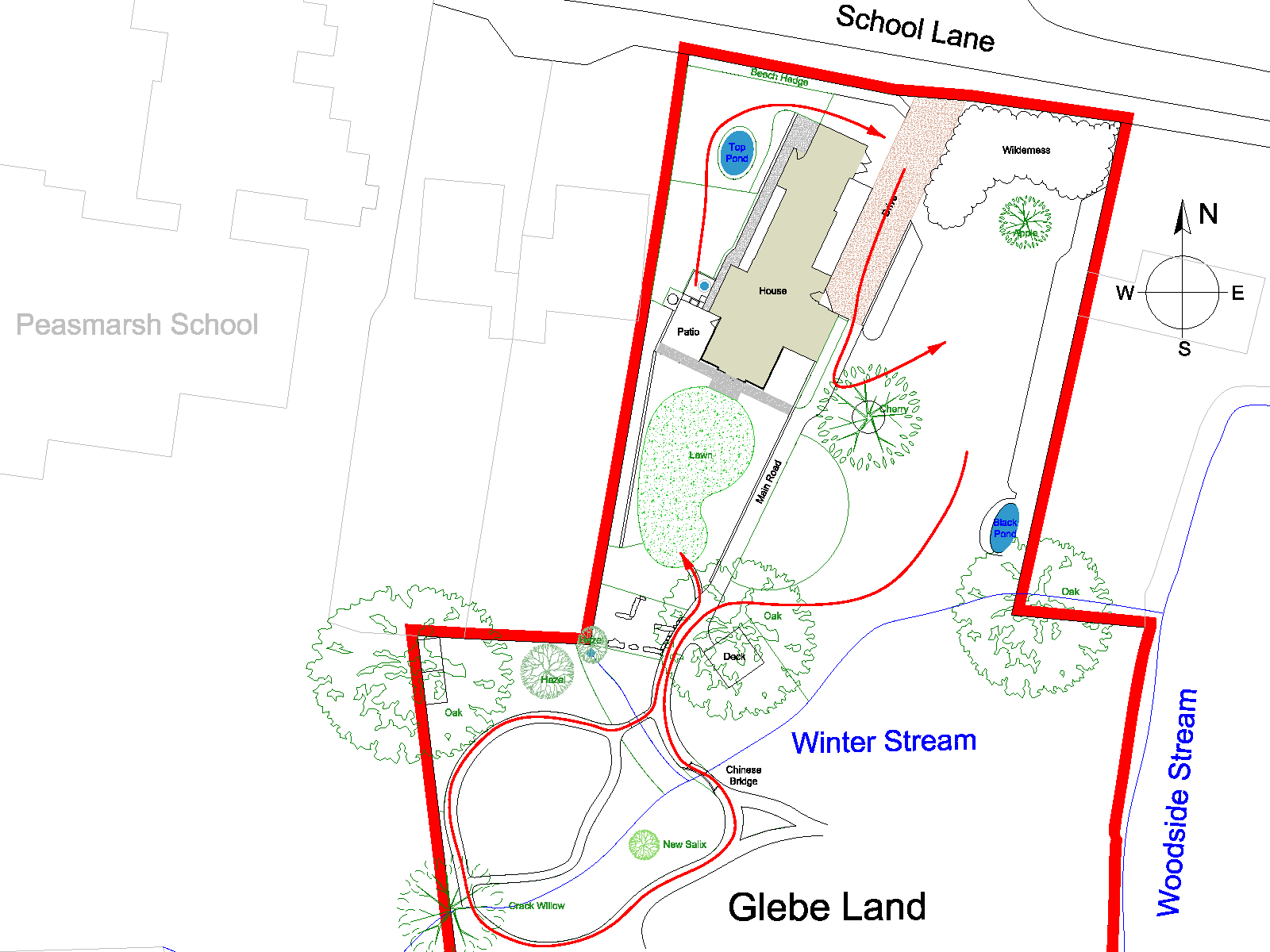
Welcome to the garden at The Old Rectory in Peasmarsh, still more of a 'potential garden' than a 'garden' even after four years.
To plagiarise Caesar [thanks to Cassius, Brutus et al he cannot sue us] : Omnis hortus in duas partes diviso est ....
It consists of the Home Garden which is 1,960 m² [0.48 acres] in area and 4,894 m² [1.21 acres] of Glebe Land previously associated with the parish. Much of the glebe land is as we found it with just some pathways driven through it but part of it has been incorporated into what can be recognised as a traditional garden.
This section of the domain takes one, bed by bed, through the garden starting at the entrance. It has been designed to be viewed as you wander through the garden. When viewing on a mobile device it is better viewed in landscape. Take a moment to orientate yourself : facing down the drive from the entrance you are facing south so east is to the left and west is to the right with north behind you.
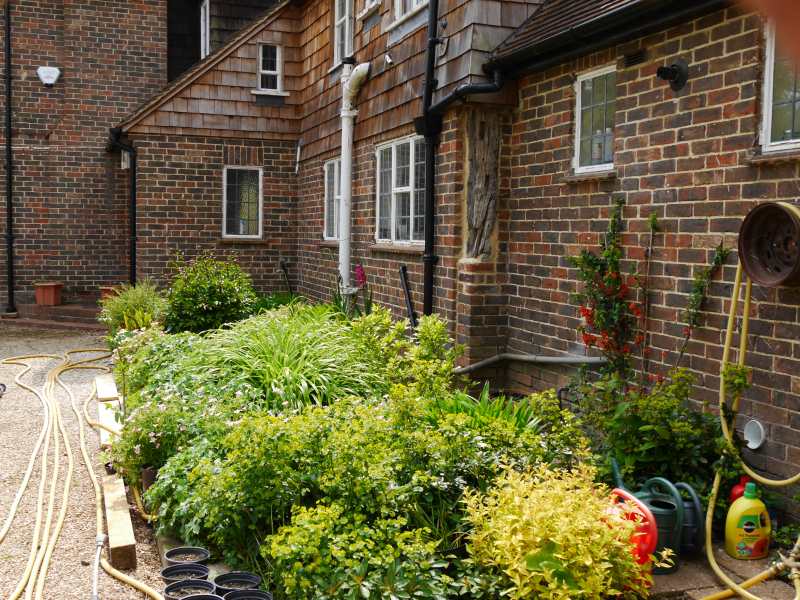
This bed lies between the driveway and the house, running from the garage to the main entrance. It is 19 m² in area and enjoys full sun in the morning but not long after solar noon it starts to lose that to the shadow of the house. The topsoil here is good with some depth although it still sits on the clay below. This bed was existing when we took over in 2015 but was heavily infested with weeds, albeit with plants worth saving.
In 2016, having spent 2015 observing, everything was dug out and the roots almost washed to remove weeds while the bed was dug over and disinfested. The retained material was then divided and replanted, including a yellow leaved fuchsia, agapanthus, some hemerocallis, some camassias, a lot of geraniums, some hellebores and some peonies. We have added a pittosporum 'Tom Thumb', a lovely yellow crocosmia ['Paul's Best Yellow'] and a Magnolia stellata to create a very eclectic mix which provides interest much of the year. Even today we are still getting weed seedlings and suckers from buried roots of brambles [but we will persevere!].
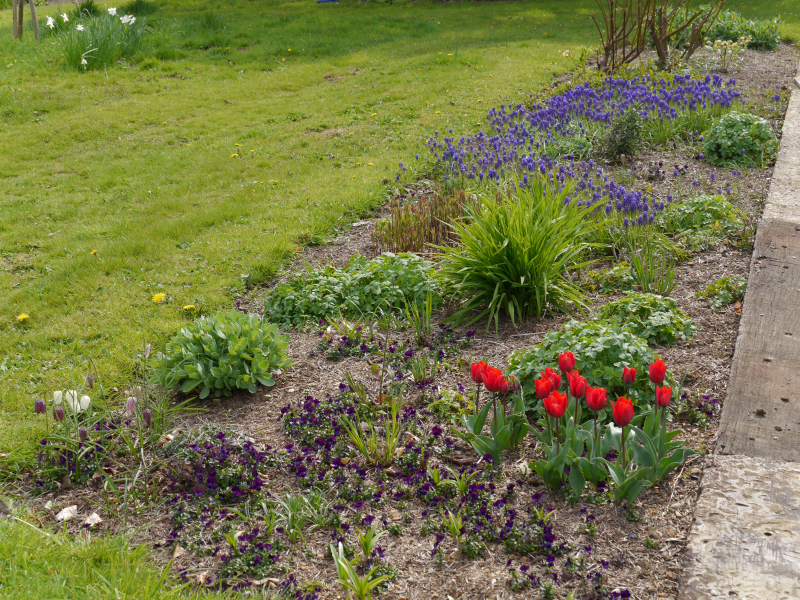
This bed runs along the east side of the driveway, separating that from the Wild Flower Meadow. It is 19 m² in area and, like its sister bed on the west of the drive, it also enjoys sun from early morning until mid-afternoon when it falls under the shadow of the house. The bed was an existing one when we took over in 2015 but equally heavily infested with weeds and what roses there were had been allowed to sucker so only the strong [wild] rootstock remained. The soil is full of pea shingle from the drive so is very free-draining and was initially full of building debris from the 1930's.
It took several years to clear the bed of debris and weeds from end to end and in that process much plant material was thrown away. The only plant still in the original position is a red-stemmed cornus, presumably Cornus alba. However, various plants were found and retained : an evergreen honeysuckle [Lonicera japonica? or L. henryi?]; a lot of Muscari armeniacum; some red species tulips; some snake head fritillaries; some Centaurea montana. The rest of the bed has been planted from divisions of plants in the sister bed, purchases and plants brought down from Chelsfield : all in all another very eclectic mix which will hopefully provide interest most of the year.
Continuing up the drive and on to 'main road' ...

The asparagus bed runs along the east side of the house and then past the Orangery Bed, next to the 'main road'. It is only 9 m² in area and is lower than the orangery bed, separated by a dwarf sleeper wall. We found asparagus growing there, up against the house wall, in 2015 and discovered that its flowers were a major bee attractor so it is not eaten. The northern end of the bed enjoys sun from early morning until lunchtime when it falls under the shadow of the house. The southern end is somewhat shaded by the cherry tree. The soil has some pea shingle from the drive so is free-draining and is relatively dry.
Other than the asparagus, a single fuchsia is the only plant retained in the bed [most of the rest were weeds!]. A trellis has been put up the house wall for a star jasmine [Trachelospermum jasminoides] to climb. For the rest, the bed is currently populated with red valarian [Centranthus ruber], some golden asclepias [Asclepias tuberosa and a single Agastache 'Kudos Gold' plus some spare geraniums transplanted from the original West Drive Bed.

This bed is tucked in between the orangery and the southeast corner of the house. It is 14 m² in area and is a relatively sunny position in summer, less so in winter. The area was partly a weedy and derelict patio and partly wild grassland when we took over in 2015. Today's soil is largely backfill from the excavation further south and west that created the formal garden and is not very good although we did add compost to try and improve it. The bed is also in the rain shadow of the house so it is relatively dry.
We started work on the bed in late 2016 once the orangery was complete and the dwarf sleeper wall had been installed between it and the Asparagus Bed to retain its soil. The main feature of planting is a group of modern repeat-flowering roses. We also planted some asclepias [milkweed] but they are proving to be short-lived, perhaps because of the climate or perhaps because of the location. We need to think again. The bed also has an existing creeper climbing up the wall of the house, assumed to be Japanese Creeper [Parthenocissus tricuspidata], not its better-known close relative Virginia Creeper [P. quinquefolia].
Turning left away from the 'main road' ...

There was a sort of 'bed' under the cherry tree when we arrived in 2015 but it was not defined, just merging into the surrounding [long!] grass. We had no idea what might be hiding there. It enjoys a little early morning sun but is really a shady bed. The soil is not too bad but quite dry because of the tree.
We have defined the bed as a circle under the tree. It is only 7 m² in area. The only items of interest already in the bed were various bulbs [narcissi, snowdrops and dog's tooth violets - Erythronium dens-canis] and a field of Cyclamen hederifolium, the cyclamen that flowers from bare tubers [corms] in the autumn. Ours are the pink variety but it would be nice to have some of the true white ones too. We are slowly planting up the bed with shade lovers, including an interesting vinca called Vinca difformis 'Jenny Pym'.
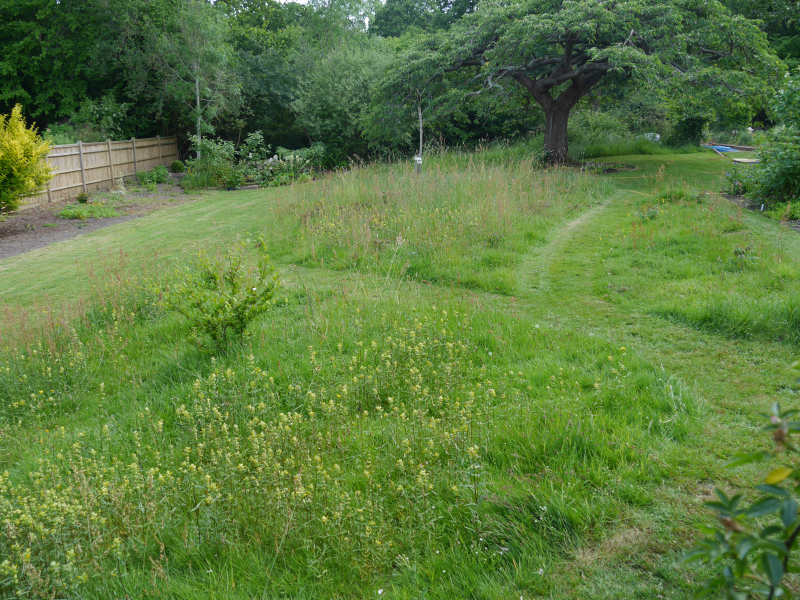
The 'wild flower meadow' occupies a large proportion of the eastern section of the home garden, stretching from the untamed 'Wilderness' section by the road all the way to under the oak tree. Only the Eastern Border bed and the beds at Black Pond lie between it and the eastern boundary. It is 600 m² in area and enjoys a lot of sun at the northern end but is quite shady at the southern end. The soil is essentially clay.
This is a classic example of a gardener's cheat : take a neglected lawn, mow a few paths through it and call it a 'meadow'. In autumn 2018 we strimmed the long grass areas back to the roots to weaken the grass and sowed some mixed wild flower seeds. Included in the mix was yellow rattle [Rhinanthus minor] which semi-parasitises grasses, giving other wild flowers a better chance. By May 2019 the yellow rattle was showing strongly but little else by way of wild flowers was appearing ... but things have improved subsequently!
There is an old cooking apple tree at the far north of the meadow, next to the wilderness, and a medlar [Mespilus germanica], a Viburnum plicatum f. tomentosum 'Kilimanjaro' plus a Liquidambar styraciflua 'Gum Ball' have been planted elsewhere. It took three years to fully 'prune' [take off major branches!] the apple. In addition, when we took over in 2015 there was a large clump of diseased stag's horn sumach [Rhus typhina] - no doubt suckers from a long-gone original - but we removed them in 2018. 2019 required a lot of pulling up of suckers from the extensive root system but it seems to have now given up. In 2019 we planted a mass of dwarf narcissi and in 2020 we planted 400 species crocus and will continue to do so into the future.
On the far side of the Wildflower Meadow ...

This bed is on the low lying ['downhill'] eastern boundary of the home garden, beyond the wild flower meadow. It runs from the wilderness area close to the road along to Black Pond and is 80 m² in area. The bed is hidden from the morning sun by the fence but enjoys full afternoon sun. The topsoil is full of humus but not very deep before the pan of clay is reached, and is decidedly wet.
In 2015 this was a mass of overgrown shrubs infested with pernicious weeds [read brambles, bindweed, nettles] and a much suckered wisteria which was essentially a weed. In the area were six rhododendrons, all apparently just the rootstock of what would have been lovely cultivars and hence probably Rhododendron ponticum, some golden lonicera [presumably Lonicera nitida 'Baggesen's Gold'], a yellow leaved privet and a mass of self-layered green and red barked cornus. It took several years to bring the shrubs back under control and clear the bed of weeds from end to end but little plant material was thrown away : it was either moved elsewhere [e.g. cornus down to the south glebe] or given away. R. ponticum is, of course, classified as an 'invasive non-native species' but it is permitted in gardens. Rather than destroy it we have taken the view that it should be retained in the medium term while new rhododendrons are established so that the ponticums can be removed [or at least reduced in number] eventually.
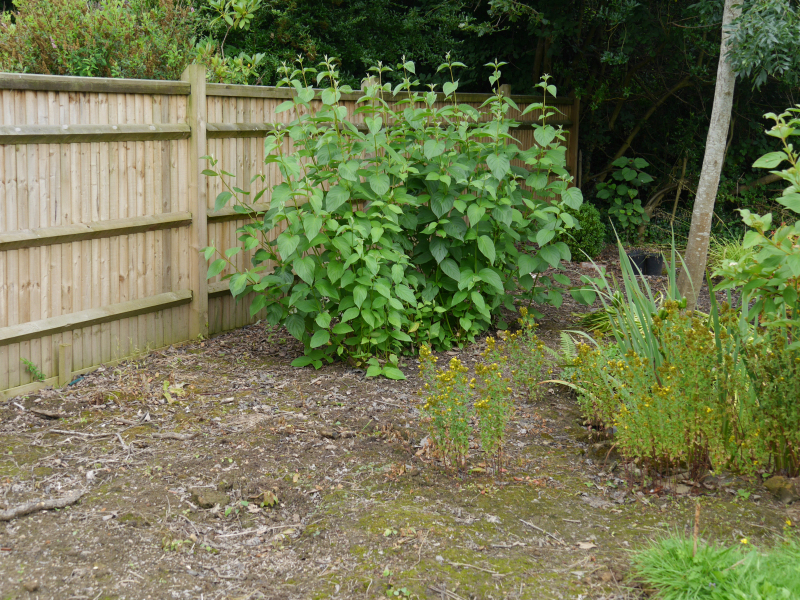
This bed hugs the east side of Black Pond immediately south of the eastern border bed and is only 8 m² in area. It too lies up against the boundary fence so is quite a shady bed with reasonable, somewhat damp soil.
We were not even aware that Black Pond existed when we took over in 2015 because the area was so overgrown with weeds and rampant cornus and the pond was almost completely choked with Iris pseudacorus, our native flag iris. We called it 'Black' Pond because the bottom of the pond was so full of decaying leaves that the water was black and lifeless [and very sulphurous!]. It was the end of 2017 before the bed was sufficiently cleared to think about planting up. [About half a ton, wet weight, of iris had to be removed!] In clearing up, however, a maybe 10 year old ash sapling - now showing signs of die-back - was retained with a large clump of Leucojum aestivum at its base, as was a limited number of the cornus and a field of rogersia, assumed to be Rogersia podophylla.
Not that much has been planted yet while the ongoing battle with weeds continues. The longer term aim is to provide a back-drop to the pond with a narrow path winding through the bed.

This bed hugs the west side of Black Pond immediately south of the eastern border bed and is only 5 m² in area. It is separated from the boundary fence by the pond and then its eastern twin so is not quite as shady. It has a reasonable, somewhat damp soil. In 2015 there was no bed on this side of the pond, the weedy grass going right to the pond edge. Two clumps of red stemmed cornus were cut back and retained when creating the bed.
A small amount of flag iris has been allowed to remain in the pond [and will need careful management to keep it under control] and a red water lily has been transferred from Top Pond to here. The water is much revived and used by a myriad of insects including water boatmen and dragonflies. It will hopefully be conducive to amphibian life in the future. The longer term aim is to fill the bed with pond-side plants.

The Jungle seems to have once been a shrubbery in the home garden. It lies just to the east of Main Road and slopes down from there, merging into the Wild Flower Meadow. It is 92 m² in area and enjoys some morning sun but is really either shaded by the cherry tree or the oak for much of the day. The soil is clay and relatively dry because of the slope.
The area was largely ignored for the first three years. However, in 2019 the task of clearing it out while retaining the wild feel was started. Rampant old shrubs which are/were there include a squamous juniper [impossible to save], a choisya [severely cut back but probably in the wrong place as it is too shaded], a berberis [possibly Berberis verruculosa, cut back and retained], a magenta deciduous azalea [almost impossible to save but we will try] and a yellow leaved spirea. All of it was run through with brambles, a very vigorous honeysuckle and a lot of self-set trees including a hazel [retained], several hornbeams, some ash and a Japanese laurel. A hornbeam hedge has been started to separate the area from Main Road and some white-stemmed brambles, Rubus cockburnianus, have been planted to take the place of the thuggish wild blackberries.

The deck bed is basically under the oak tree, part in the home garden but mainly in the glebe land. It is bounded on the west by the yellow brick road and surrounds the deck on three sides, sloping steeply down to river pond on the south side. It is 92 m² in area. Because of the oak it is mainly a shaded bed although some of it does get a bit of afternoon sun. The bed was created in the area where there was an overgrown hedge [complete with barbed wire fence] so there is some humus in the soil over the underlying clay and moisture is reasonable.
Final preparation and early planting could only start in late summer 2018 when the deck had been constructed. To some extent avid reading of Beth Chatto has guided the planting although in the sunnier parts of the bed it has been a case of 'where can we put this?' with plants 'rescued' from Chelsfield and plants bought in multiples not needed in the intended location. The western edge of the deck itself has been [dwarf] hedged with Japanese Holly [Ilex crenata] instead of box - which is now prone to blight and/or box moth and its caterpillars.
Following the yellow brick road ...
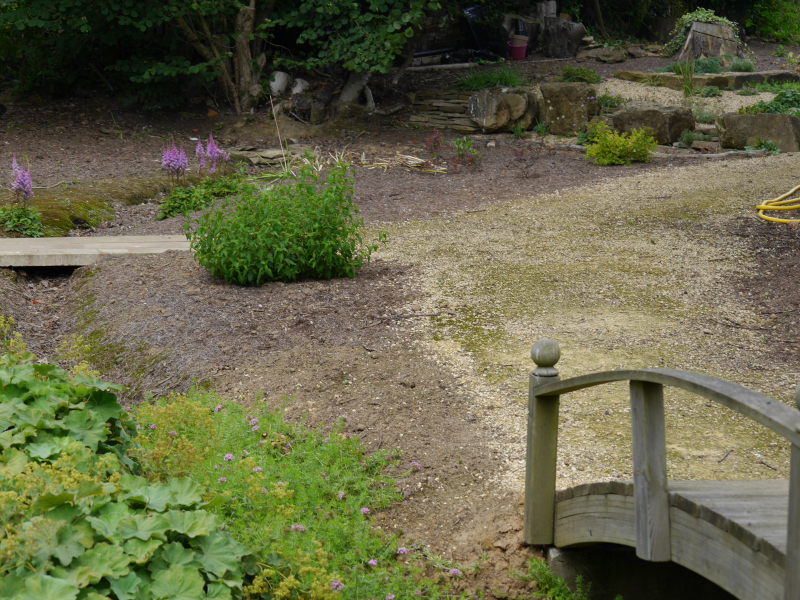
The two spring beds are either side of the rill that runs from the winter spring down to Winter Stream. They are therefore entirely in the glebe land. Both are cut in two by the path that runs across the rill. The yellow brick road runs to the side of the eastern spring bed which is 27 m² in area. The northern end of this bed is relatively shady although it does enjoy some afternoon sun while the southern end is a lot sunnier. The soil at the north end is reasonable and it is quite moist, becoming clayier as one moves south.
The bed was initially a dumping ground for grubbed out but rooted surplus plant material but now it is slowly taking on a more planned aspect. The intention is to keep all of the planting at low level so that it doesn't obstruct the view from the house past the formal garden and out across the glebe land.
Across the Chinese Bridge there are three beds plus the rest of the glebe land to wander through ...
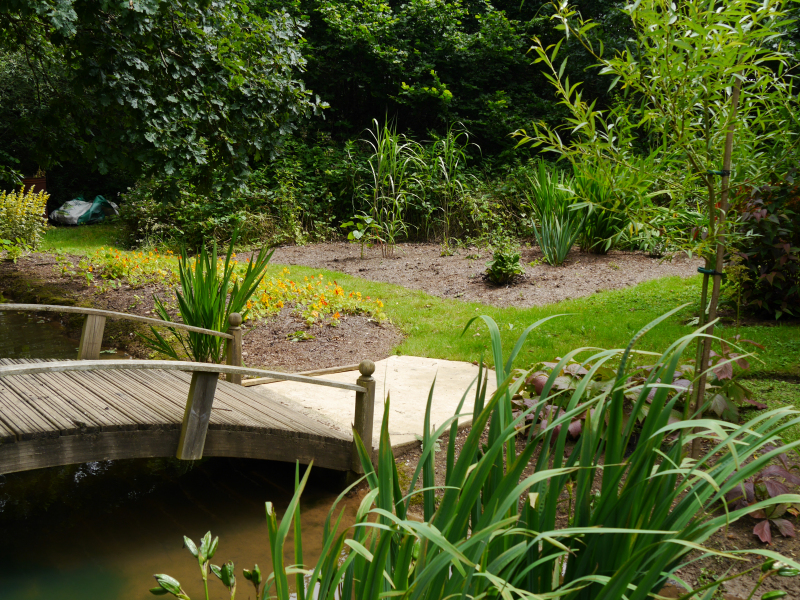
The bed on the left is brand new - it was only created in 2020. A path bisects it, the part nearer the pond being on hold pending further work on the pond itself. This was the site of our earliest bonfires so the soil is rich, if somewhat short of humus.
The part next to the pond will ultimately be filled with pondside planting and the other side will hopefully be a natural buffer between the gardened land and the natural glebe. So far it has been used as a dumping ground for spare plants other than some tall grasses and a shrub-like willow.
Feel free to wander down to the back of the property where you will find Woodside Stream and the future pond / flood defence ...

This is a small bed across Chinese Bridge to the south of Winter Stream where the paths into the glebe land split. It is just 8 m² in area.
As with all of the glebe land, this bed has been carved out of the scrub shaded by the many oak trees so it is essentially a shady bed. The soil is quite moist and, because it has been the site of fires in the past, it is laden with ash. The planting is new and, as everywhere, the fight with weeds and their seeds continues.
Following the grass path to the right on the south side of Winter Stream ...
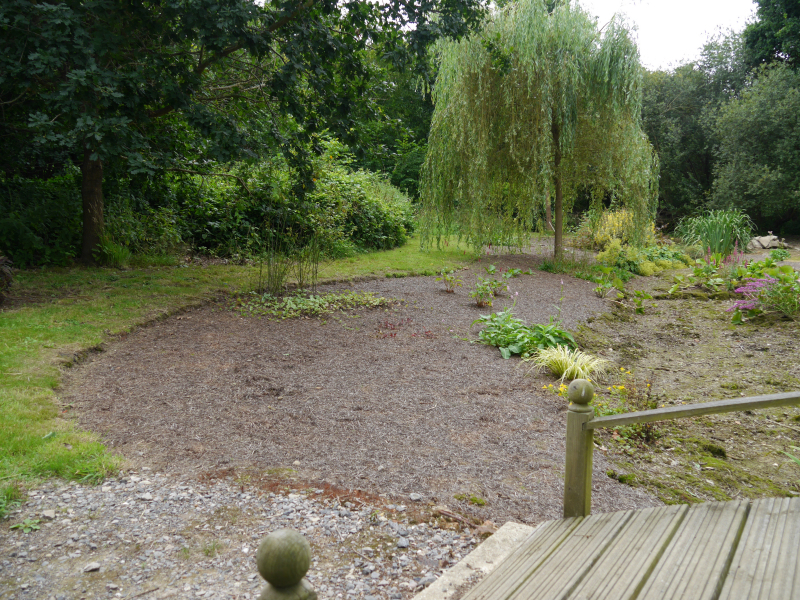
The South Glebe area is a relatively small strip of a bed just to the south of Winter Stream : the edge before one faces the 'unknown terrors' of Terra Incognita, the rest of the glebe [in practice we have only used 15 to 20% of the glebe to create today's garden]. It is 120 m² in area and is quite shady because of the young [teenage?] oaks in Terra Incognita and, now, the weeping willow that we planted in the area close to the stream. The soil is silty clay that stays damp virtually all year round.
We planted a golden weeping willow, Salix x sepulcralis 'Chrysocoma' in the spring of 2015 by hacking out a square metre of bare land from the weed-infested area. We later learnt that much of the infestation was water hogweed, described by some as "the most poisonous plant in the UK". It took the rest of 2015 and much of 2016 to bring the area under control and planting only really started in 2018 while residual weed seeds were allowed to germinate in order to be killed [still an ongoing process!]. The longer term objective is to create a bed that will provide background to the view from the house across the formal garden and subsequent beds. A mix of herbaceous perennials and some shrubs should do the trick.
Recrossing Winter Stream at the dam ...
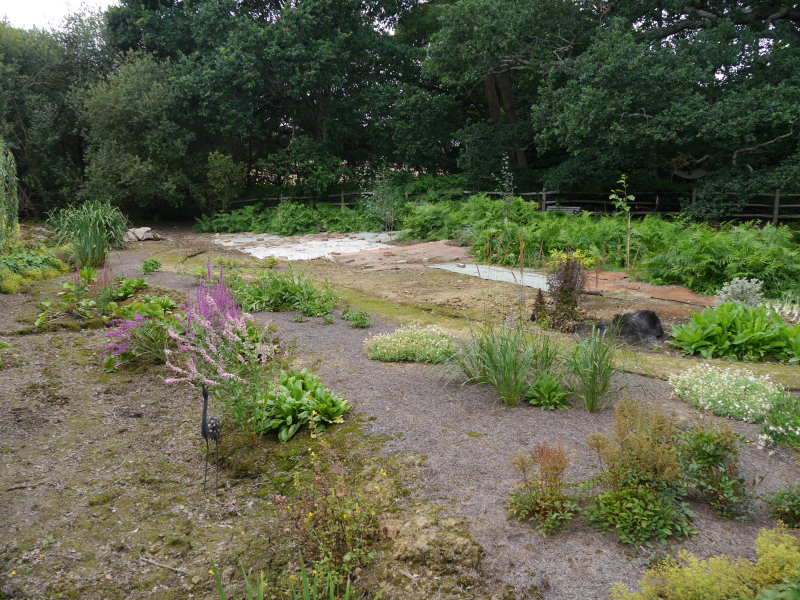
The North Glebe is the relatively large area between Winter Stream and School Oak to the west of Spring Bed West. It is 220 m² in area. It is a sunny bowl once the sun comes round the oak tree although it will have some shade along the bank of the stream once the weeping willow in South Glebe grows tall. It slopes up from the stream to School Oak. Fundamentally it is a moist clay soil because of the sub-surface water that drains down from the field to the west. Hopefully the soil will improve as we mulch and cultivate [although much of the area has been and still is - 2019 - mulched with old carpet].
All of the glebe land had been abandoned years before we took over in 2015. It was a mass of brambles with nettles, bindweed, bracken etc. that have been slowly tackled over the following years. In the early years North Glebe was a useful spot to have the many bonfires needed as we cleared the garden but in 2019 that was discontinued and the task of developing the garden in this area was started : three white-barked birch and two magnolias have been planted as a background when viewing from the south looking towards School Oak. The overall thinking [for the longer term] is to have herbaceous perennials down near the stream blending into shrubs and trees as the slope ascends.

The school oak bed is tucked up in the corner above and to the north of North Glebe under the large oak in the school's 'forest school'. It is 120 m² in area and is totally shaded by the school's oak with some help from a hazel growing in the bed. The topsoil is excellent, being almost pure leaf mould, but it still lies on top of the clay subsoil and is not that thick. In winter it is quite a wet bed because of the sub-surface water that drains down from the field to the west but in the summer it is in the rain shadow of the oak so quite dry. The combination is quite a challenge to gardening.
All of the glebe land had been abandoned years before we took over in 2015. It was a mass of brambles with nettles, bindweed, bracken etc. that have been slowly tackled over the following years. The bed is slowly filling as we keep fighting the bramble seedlings and bracken. Some Gillenia trifoliata have been planted where they can enjoy speckled sunlight and further back are various drought-tolerant ferns [yes, they do exist!]. The back of the bed to the north has been taken for maintenance : it is where the compost heaps and storage area are.
Before crossing the spring rill ...
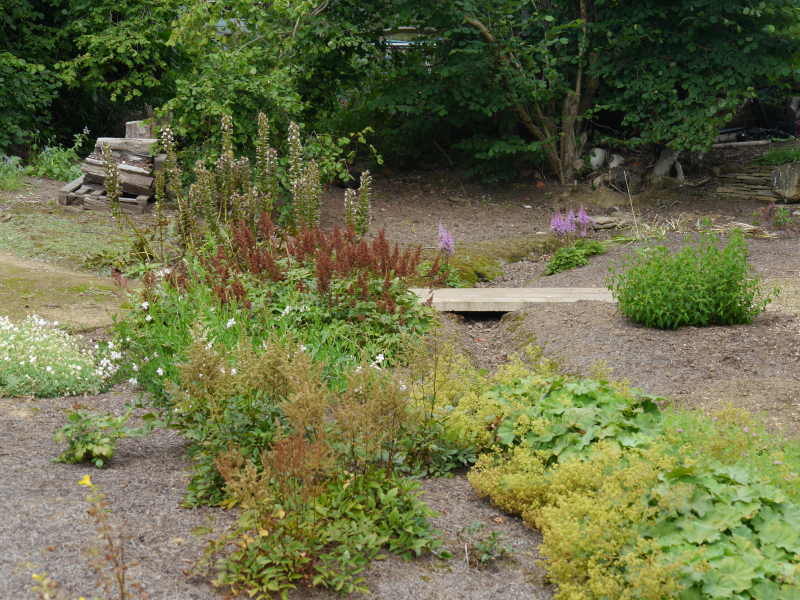
The western spring bed merges seamlessly with the North Glebe and School Oak areas and is 30 m² in area. Like its sister bed on the east of the rill, the northern end of the bed is also relatively shady, not just because of the oak but because of the hazel at the corner by the spring. It does enjoy some afternoon sun however, while the southern end is a lot sunnier. The soil at the north end is reasonable and it is quite moist, becoming more clayier and wetter as one moves south.
The first planting in this bed was as early as 2016 but it was just a 1 x 1 metre patch carved out of the glebe land weeds to take some red astilbe brought down from Chelsfield. They thrived in the damp but really only became part of the garden in 2018, having been joined by some white Astilbe 'Cappuccino' in 2017 in a second square metre patch.
Crossing the spring rill and turning left back towards the house ...
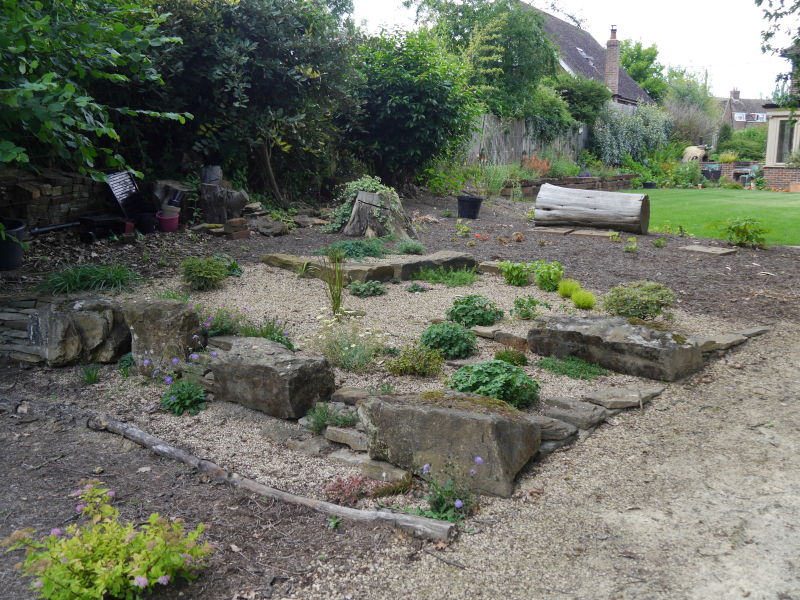
There is quite a drop from the level of the formal garden to the glebe land. The west side of the yellow brick road seemed an appropriate place to have a rockery to accommodate the drop. It is shaded by the oak for most of the morning but then enjoys the sunshine as the sun moves round and is 40 m² in area. There was only an overgrown, primarily holly hedge under-canopied with weeds and straggly grass here when we took over in 2015 so we spent the first two years trying to kill all of that. Once the Wealden sandstone rocks were placed we back-filled with good topsoil heavily laced with agricultural grit sitting on some rubble so it is rich but well drained soil.
Planting is now complete with a range of rockery-scale trees and shrubs plus a mix of perennials.
There are three beds in the formal garden ...
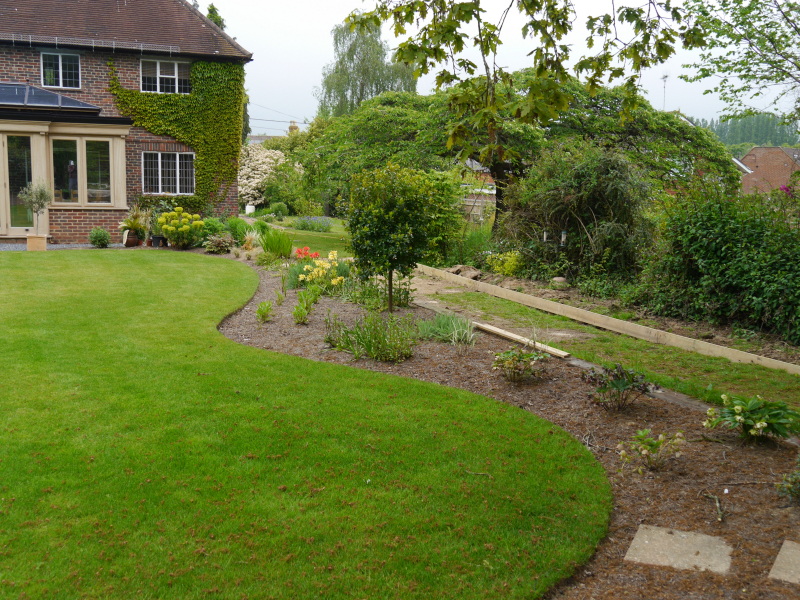
This bed stretches from the orangery south to the shade under the oak tree, alongside the main road. Consequently, it enjoys full sun at the northern end but is quite shady at the southern end. The entire formal garden was levelled in 2017 by carving deep into the clay on the west and adding a little bit of fill on the east. The soil is therefore essentially clay with a little humus in the mix from the original [poor] top soil. The bed is 42 m² in area and all the planting is new.
The picture was taken in the spring of 2019 but the intention is to have a relatively tall 'prairie' style of planting at least as far as the arbutus on the edge of the more shaded section. That will visually divide the formal garden from the main road. The bed is already planted with various heleniums, achilleas, echinaceas and grasses. A couple of deciduous azaleas provide some early colour and, before that, narcissus 'Tête à Tête' brightens the bed. At the shady end some hellebores rescued ['liberated'?] from the previous garden in Chelsfield have been planted and we are trying out a compact form of kalmia there too.
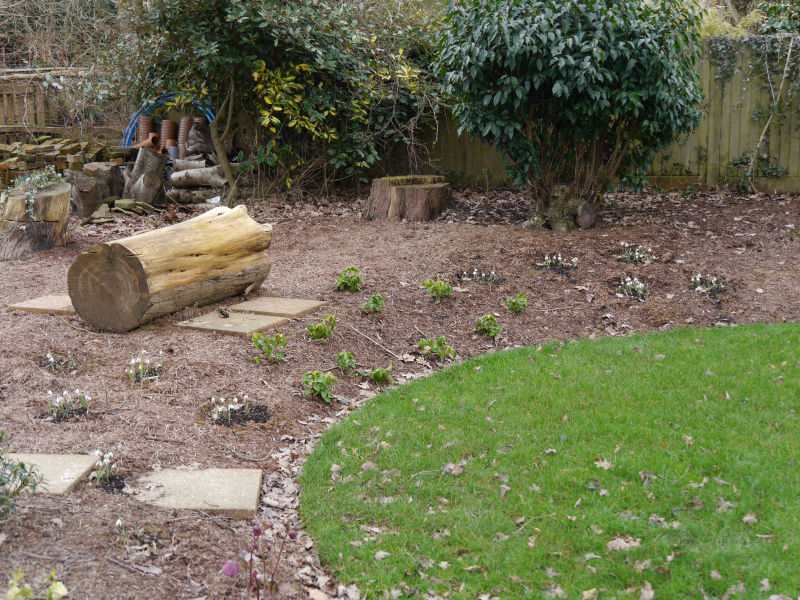
This bed sits between the east and west beds of the formal garden, the closest part of that garden to the oak tree. Accordingly, it is a relatively shaded bed. This part of the garden was dominated by full grown trees too dominant for the space [part of one trunk provides a bench now] and overgrown shrubs when we took over in 2015. What it does mean though is that the topsoil is humus rich, albeit on the clay not far below. It is 32 m² in area.
It took several years to fell the trees and bring the shrubs under control. A Portuguese laurel [Prunus lusitanica] and an elaeagnus that has reverted from a variegated yellow-leafed form have been retained but everything else is new planting. One of the new plantings is a tall black bamboo - assumed to be Phyllostachys nigra which was invading North Garden from the garden up the hill and has been moved to here.
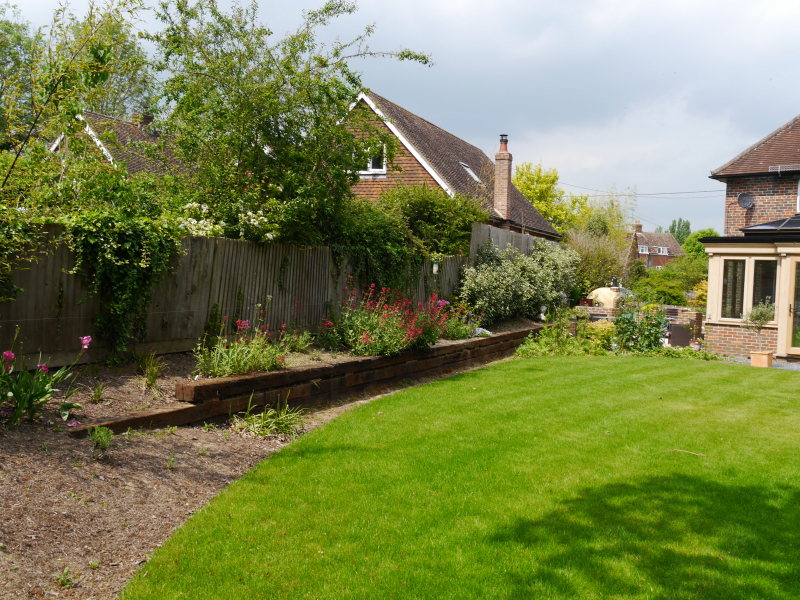
The west bed of the formal garden stretches south along the west fence from the orangery to the south bed of the formal garden. It includes the bed on the west of the patio and is 56 m² in area. The area enjoys full morning sun for most of its length although the far south is shaded to some extent by the oak tree. The entire formal garden was levelled in 2017 by carving deep into the clay on the west and adding a little bit of fill on the east. This bed is mainly the narrow rump of the natural level held back by the sleeper wall. There is a little top soil here but it is essentially clay. There is some moisture but the bed is well drained because of the cut where the sleeper wall is. A small section of the bed at the orangery end is at lawn level so just clay subsoil which will hopefully improve over the years as it is cultivated. All the planting is new.
The picture was taken in the spring of 2019 when the bed was still being developed so there is a lot of red valerian [Centranthus ruber, not to be confused with herb valarian - Valeriana officinalis] acting as a 'filler'. The high level bed does have quite a lot of bulbs planted and a few specimen plants already, and three pyracanthas have been planted against the fence to soften the look [if thorny shrubs can be said to soften anything]. At the far end near the patio we have grown an Elaeagnus × ebbingei hedge for the same purpose and that is already well established. The lower level bed at the orangery end has a lot of herb valerian [see earlier comment] acting as a filler, again with a few specimen plants.
The sleeper wall was built with packers between the top row of sleepers and the ones below in order to create planting pockets. Over time we will continue to plant up this gap with suitable plants such as those already seen.
Walking through the patio area ...

The Kitchen Garden stretches from the patio to North Garden on the west of Home Garden behind the house. It is 63 m² in area and is relatively shady because of the houses, the western side being sunnier, but it does benefit from sun in the middle of the day. Like all of this part of the garden, the soil is quite rich and moist.
Despite its name, this is not a traditional 'kitchen garden' just growing vegetables for eating. Now that it has been rescued from the weeds it is a mixture of ornamentals - including some highly poisonous aconites! - and vegetables. It also has some small trees which might belong in a traditional 'kitchen garden' but might equally belong in a 'herb garden' : a bay tree and a Sichuan pepper tree.
There is much talk of fighting weeds on these pages but there is an additional fight in this area of the garden : fighting whatever is enjoying the vegetable seedlings [probably pigeons as the brassicas seem to be a favourite]. If only they would nibble the aconites instead.
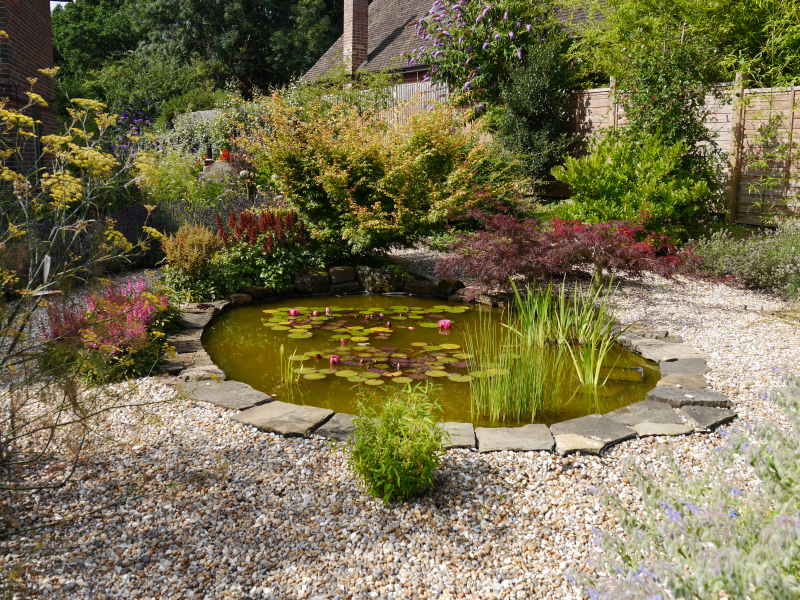
Top Pond is set into the south eastern corner of North Garden, assuming that the gravel path is counted as part of the latter. It consists of water planting plus a few edge plants and is 14 m² in area. This area of the garden is relatively sunny. The pond has a ~400 mm wide shallow shelf - 100 to 150 mm deep depending on how full the pond is - all the way round. The soil just outside of the pond, like North Garden and for the same reasons, is quite rich and moist.
In 2015 this part of the garden was overshadowed on the west by tall evergreen trees with three metre high brambles below. Top Pond was found by nearly falling into it : it was covered in duck weed, had a venerable and much too large water lily and also had a weed infested floating 'island'. It took us 5 months to realise that the pond was populated by a shoal of small golden carp, hiding below the surface mess.
Fairly early on we planted two acers on the edge of the pond, rescued some astilbes already there and planted some more astilbes. The water lily was also pulled out and the younger bits potted up and dropped back in. Marginals have now been planted in baskets on the shelf.

The North Garden is immediately behind the beech hedge that borders the road in the north west of the property. It curves around Top Pond and adjoins the Kitchen Garden on its south side and is 85 m² in area. The bed is relatively sunny and benefits from an almost leaf mould soil from the trees [and weeds!] that occupied this part of the garden when we first arrived. Although this is the high point of the garden, the soil is also relatively damp because it benefits from the [just] sub-surface water running down the hill from the west on top of the clay layer.
When we took over in 2015 this part of the garden also qualified for the title of 'jungle'. It was overshadowed on the west by tall evergreen trees with three metre high brambles below. The beech hedge was rapidly turning into a line of beech trees and Top Pond was found by nearly falling into it but by the end of the year the worst had been cleared away and old carpets thrown out of the house were being used as weed-killing mulch [carpets that are still being used for that purpose today - 2019 - in the glebe land].
Since then the weed seed fight has continued and much of the bed has been carpeted with [now self-sown] nasturtiums, borage and Verbena bonariensis although some specimen plants have been incorporated, particularly at the southern end just west of Top Pond. The area was also used initially as temporary storage land for trees and shrubs moved out of other areas and some of those are still in situ.

The herb bed runs along the top of the northern end of the sleeper wall on the west of the house next to the path around Top Pond. It is just 8 m² in area. Conditions are not ideal for herbs as it is shaded by the houses for much of the day and is also quite moist because of the [just] sub-surface water running down the hill from the west on top of the clay layer. The soil is quite well provided with humus from when the garden was derelict and tree leaves were continuously accumulating.
The reason that this bed is used for herbs is convenience : it is just outside the back door. Having said that, it is also seen from the west windows of both kitchen and dining room so there is a scattering of ornamentals among the herbs, primarily from the Primulaceae family.